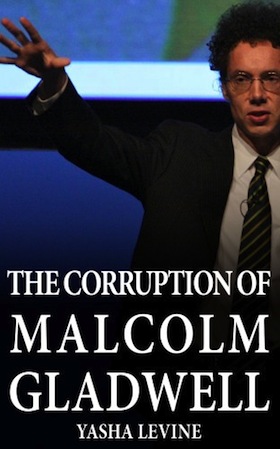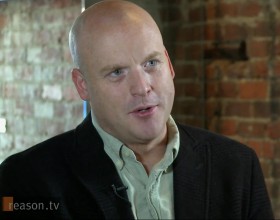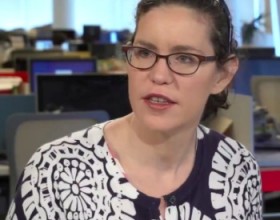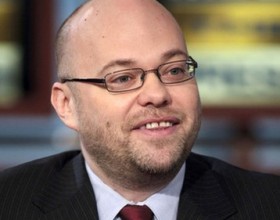On August 15, 2012, in West Jerusalem, a small group of Palestinian teenagers was attacked by a mob of Israeli youths. The New York Times described it as an "attempted lynching." The Israelis, who had apparently planned on lynching someone that night, set their sights on a couple of Palestinian kids hanging out at a busy city square, chased one of them down and then beat him until his heart had stopped. His name was Jamal Julani, a 17-year-old resident of East Jerusalem. He only survived because a medical student happened to be on the scene and was able to resuscitate him in time. The beating took place in full view of hundreds of people, who stood by and watched without intervening. According to an eye witness in account in The Jerusalem Post, "People who tried to resuscitate the Arab were mocked by the crowd of Jewish youths."
But The Atlantic's Jeffery Goldberg wouldn't have any of it. He downplayed the seriousness of the attack, and went after a New York Times reporter for implying that the lynching was a sign of systemic racism in Israel. He then tried to whitewash the violence and then excused it by pinning the attack on poor, uneducated Arab Jews:
This sort of thing isn't actually that new. As someone who covered the funeral procession of Meir Kahane, the racist rabbi assassinated in New York more than 20 years ago, I can attest to the fact that Jewish hooligans, mainly from Jerusalem's poorest neighborhoods (and many who are descendants of Jews who fled, or were expelled, from Arab countries), will periodically set themselves upon innocent Arabs. They did it at the funeral, and in subsequent incidents.
Goldberg packed in a lot of evil lies into that one small paragraph.
First, there's his sleazy insinuation that Arab Jews are somehow solely responsible for the violence against Palestinians, a disgusting expression of Ashkenazi racism that blames darker-skinned Sephardic Jews for all the ills of Israeli society.1 Then there’s his suggestion that the brutal beating of Julani was somehow understandable or even justified because the Israeli kids doing the beating were “mainly … descendants of Jews who fled, or were expelled, from Arab countries.” Meaning that the lynched Palestinian kid had only had his own Arab brothers to blame for what happened to him. But the juiciest lie is in what Goldberg left out...
Goldberg boasts about coming face-to-face with Jewish hooligans while covering the funeral of the ultra-rightwing anti-Arab rabbi Meir Kahne, as if to give readers the impression that his familiarity with Jewish anti-Arab extremism comes from his experience working as a journalist in Israel. But it's a bit more complicated than that. Goldberg's connection to anti-Arab extremism is deeper and much more personal. Fact is, Goldberg self-consciously dodged having to tell his readers the truth. That is: he was himself a one-time die-hard follower and believer in Kahane's racist rightwing extremist ideas. Goldberg might condemn their anti-Palestinian violence today and call it “appalling,” but he would have been openly supporting and cheering it on when he was the same age as the Israeli thugs who lynched Julani.
Goldberg has been trying to play the role of liberal Zionist lately, and clearly doesn't like bringing up his ultra-rightwing past. But he had no problem describing his childhood conversion to Kahane’s violent anti-Arab ideology in his 2008 memoir Prisoners—the thing to remember is that Kahane founded the Jewish Defense League (JDL), which the FBI and the State Department have classified as a terrorist organization, no different than al-Qaida.
Here's how he describes it:
"And soon enough I came across the writings of Meir Kahane, on a high shelf, and it was Kahane who provided a not un-Panther-like but specifically Semitic model of self-defense. Kahane was the Brooklyn rabbi who founded the Jewish Defense League in 1968 to shake Jews out of their fatalistic and feminized passivity. He argued, infamously, in favor of the bat, the bomb, and the gun. (“Every Jew a .22,” he said, to the shame and horror of the Manhattan Jewish elite and to the secret joy of every beaten-down Jewboy in the tristate area.) . . . But for a time he held all the answers for me. In the locker room, I was a kike, but in the sanctuary of the library, I was a revolutionary kike, one of Kahane’s chayas, a beast, a street-fighting Jew.
What exactly did Kahane inspire in the the geeky “beaten-down Jewboy” from Long Island to fantasize about being part of Kahane's yarmulke-wearing brownshirt goon squad? FYI: The chayas were the paramilitary arm of the Jewish Defense League first deployed by Kahane to square off against inner city blacks and "frighten the anti-Semite to the roots of his soul."2
Well, at the time of young Goldberg became "fascinated" with the teachings of Meir Kahane, the rightwing orthodox rabbi had moved from Brooklyn to Israel and was calling for the mass ethnic cleansing and "slaughter" (in Kahane's own words) of all Arabs living in Israel and the Occupied Territories.
In 1980, Kahane was arrested in Israel “on charges that he planned armed terrorist attacks on West Bank Arabs to avenge the killing of Jews in the occupied territory,” reported UPI on May 1980. The report noted that the “New York-born rabbi and some followers had organized an armed underground against Arabs in the West Bank town of Hebron.” Later, in 1988, Kahane's political party would be banned in Israel for espousing racism—no easy feat in Israel’s racist culture—and he was barred from taking his seat in the Israeli Knesset. In 1990, after spending nearly two decades agitating for the violent ethnic cleansing of all non-Jews from Israel, Kahane was whacked in Manhattan by an Egyptian man. Four years later, a Kahane follower would finally carry out the rabbi’s plan for Hebron and massacred 29 unarmed Palestinians in a mosque, cutting them down with a machine gun as they prayed.
Kahane developed his violent rightwing politics while still in America, using the Jewish Defense League and its chaya brownshirts squads to terrorize inner city blacks, Muslims and Soviet officials on U.S. soil. In 1971 Kahane was convicted of manufacturing firebombs in New York. The next year, JDL was suspected of firebombing the offices of a promotor Sol Hurok in New York to protest his booking of Soviet artists for U.S. tours. The bomb didn’t stop the tours, but it did manage to kill young woman. In 1973, Kahane kept pressing his followers to keep trying to carry out a successful assassination, writing in a letter: “if we can’t get someone to shoot a Russian diplomat (anyone), we are Jewish pigs and deserve what we get.” The Southern Poverty Law Center described Kahane's JDL as a hate group "that preaches a radical form of anti-Arab Jewish nationalism" targeting Muslims, diplomats, critics, and even Jews it deems "not Jewish enough." JDL was implicated in a number of bombing attacks on Soviet and Arab office properties on U.S. soil, leading the FBI and the U.S. State Department to classify the JDL as a “right-wing terrorist group.”
Kahane never served any time in the U.S. probably because of his close ties to various intelligence services. According to False Prophet: Rabbi Meir Kahane : From FBI Informant to Knesset Member, Kahane worked as a FBI informant starting from the early 1960s and throughout his career enjoyed the backing of Mossad and ultra-rightwing factions political factions. But the man clearly got out of hand even for his spook handlers. Eventually, the FBI, Israel and even the U.S. State Department labeled the JDL a "terrorist organization."
But Kahane didn’t mind the terrorist label; he aspired to it.
In a 1972 Playboy interview, Kahane admitted that there was not much difference between him and Nazi white supremacists:
PLAYBOY: Then the only difference between you and, say, the American Nazi Party is that they're wrong and you're right?
KAHANE: I can't put it better than that.
How long did Goldberg's fascination with Kahane last?
In Prisoners, Goldberg writes that he became disillusioned "later in life" when he "would come to know Kahane personally." Later in life? How much later?
Goldberg said that he had “grown disenchanted” with Kahane’s ideas by the time he went to college in the 1980s, but admitted that he still couldn't help being drawn to the bearded Zionist warrior: "in a speech he gave to hundreds of students—most of whom were properly liberal and predisposed to loathe him—he laid out what he saw as the hypocrisy of Jewish life in America in an unapologetic, ribald, and revolutionary way, and we surrendered momentarily to his charisma."
And Goldberg was still sweet on Kahane in 1990, when the rabbi was shot by an assassin. He recalls attending the funeral in Jerusalem and watching in disgust as Kahane's supporters ran around screaming “Death to the Arabs!” and beating any Palestinian they came across: "Kahane would have been proud of his mourners, and he would have called the Jewish soldiers who beat them back kapos and quislings. There was no space in my heart for such a man." Yet he quickly added that "when [Kahane's] grandsons asked me what I remembered of him, I answered, 'He had very profound thoughts,' which was true."
That doesn't sound like disenchantment. More like Goldberg's in denial about his true feelings.
So the question is: Why the sudden shyness? Why did you boast about covering Kahane's funeral without ever noting that you was once a follower? It didn't seem to bother in 2008, when you published his book. So why should it now?
So come on, Jeffrey, why not relax and let your inner brownshirt chaya hang loose? Like you did in this 2006 New Yorker interview about your experience working as a jailor in Israel's largest detention camp for Palestinian political prisoners:3
“It was hopelessly exotic for me. I mean, I’m from the South Shore of Long Island, and then all of a sudden I’m in the Negev Desert, by the Egyptian border, as a prison guard in what’s probably the largest prison in the Middle East, guarding the future leaders of Palestine. It was pretty exciting.”
Yasha Levine is a co-founder of the S.H.A.M.E. Project. Read his book: The Corruption of Malcolm Gladwell.
Click the cover, buy the book!
- Hell, you don’t have to be an expert on Israeli-Palestinian clusterfuck to realize that Arab Jews can’t be blamed for anti-Palestinian violence. After all, what’s one “attempted lynching” of a Palestinian kid in West Jerusalem, compared to, say, the systematic bombing of a civilian population in Gaza with phosphorous bombs? [↩]
- From Kahane's The Story of the Jewish Defense League: "One of the things we had done in our efforts to obtain well-trained, strong, and tough Jews for effective action against Jew-haters was to create a special group of fightersbwhich we named the Chaya Squad. The word chaya in Hebrew means “beast,” and we wanted to develop Jewishb“beasts” or “animals” who would frighten the anti-Semite to the roots of his soul. They served an invaluable function in the changing of the Jewish image in America. . . . It was a thing of joy to find a big, strong Jewish youngster band train him to defend Jewish honor, bodies, and property. It was an even more satisfying thing to watch so many of the Chayas go into battle with their yarmulkes on their heads. . . . the yarmulke had come to mean something special for them. It shouted out: “I am a Jew and, Jew-hater, as you get beaten I want you to know that a Jew is doing it.” It was repayment for the cutting off of Jewish beards while Nazi soldiers laughed. [↩]
- In the early 1990s, Goldberg served as a prison guard at Ktzi'ot, Israel’s largest detention camp for Palestinian political prisoners. The prison has long been criticized for its inhumane conditions, including frequent beatings, lack of drinking water and forced labor. Among the hundreds of books forbidden to prisoners at Ktzi'ot have been The Lord of the Rings and Hamlet. In Prisoners, Goldberg described a scene from Ktzi'ot in which his friend repeatedly hit a Palestinian prisoner in the head with a with a heavy, sharp-edged army radio, beating him to a bloody pulp, a beating that Goldberg "deduced was prompted by something [the prisoner] said." Goldberg admits that he lied to cover up the crime: "I found another military policeman, and handed off the wobbling prisoner, who was by now bleeding on me. 'He fell,' I lied." [↩]








